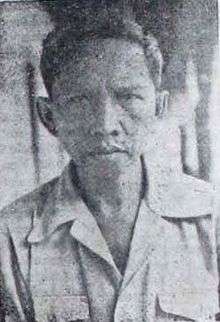Sekarmadji Maridjan Kartosoewirjo
| Soekarmadji Maridjan Kartosoewirjo | |
|---|---|
 | |
| Imam of the Islamic State of Indonesia | |
|
In office August 7, 1949 – June 4, 1962 | |
| Preceded by | position created |
| Succeeded by | position abolished |
| Personal details | |
| Born |
January 7, 1905 |
| Died |
September 5, 1962 (age 57) |
| Spouse(s) | Dewi Siti Kalsum |
Soekarmadji Maridjan Kartosoewirjo (January 7, 1905 – September 5, 1962) was an Indonesian Islamic mystic who led the Darul Islam rebellion against the Indonesian government from 1949 to 1962, with the objective of overthrowing the secular Pancasila ideology and establishing Negara Islam Indonesia (Islamic State of Indonesia) based on sharia law.
Early life
Kartosoewirjo was born in Cepu, an oil-producing town in Central Java, son of minor government official. His education was mostly in secular and Dutch-medium schools. While attending NIAS (Nederlands-Indische Artsen School/ Netherlands Indies Medical College) in Surabaya, Kartosoewirjo boarded at the house of Islamist leader Tjokroaminoto and became actively involved in Tjokrominoto's PSII (Partai Sarekat Islam Indonesia/ Indonesian Islamic Union Party). Kartosoewirjo abandoned his medical studies to be fully immersed in politics.
While touring Malangbong, near Garut in West Java, Kartosoewirjo met and married daughter of a local PSII leader. He settled down in this area, where he established a madrasa. In 1937, he resigned from PSII to establish his own political movement advocating a future Islamic State of Indonesia based on Islamic law.
Leading the Darul Islam
During the Japanese occupation of Indonesia (1942–1945), Kartosoewirjo established armed militias in Garut area, one of many such groups supported and armed by the Japanese in order to help them resist any future Allied invasion. During the Indonesian National Revolution, his Darul Islam militia remained in amicable terms with the secular Republican forces until the latter withdrew from West Java according to the terms of Renville Agreement in 1948, while Kartosoewirjo continued the guerrilla struggle against occupying Dutch forces. After the second Dutch offensive (Operatie Kraai) on December 1948, Republican guerillas slipping back into West Java was attacked by Kartosoewirjo's militia, resulting in a triangular war between the Republican forces, the Darul Islam, and the Dutch army.
On August 7, 1949, he declared establishment of Negara Islam Indonesia (Indonesian Islamic State) with himself as Imam. After the transfer of sovereignty from the Dutch, Kartosoewirjo refused to acknowledge returning Republican authority and continue attacking returning Republican forces, eventually culminating to a full-blown insurgency.
During the 1950s, weak central government and uncoordinated military response from the government allowed Darul Islam to flourish, controlling one-third of West Java and even launching raids as far as the outskirts of Jakarta. Islamic rebels in South Sulawesi and Aceh joined the Darul Islam and acknowledged Kartosoewirjo as their highest authority through in practice there was little coordination between the rebels in the different provinces. In 1957, agents sent by Kartosoewirjo unsuccessfully attempted to assassinate Sukarno by grenade attack during a primary school function at Cikini, Central Jakarta.
Defeat and Death
Declaration of martial law in 1957 and establishment of Guided Democracy by Sukarno in 1959 proved to be a turning point for Darul Islam's fortunes. The military introduced effective "fence of legs" method to encircle the guerillas' mountain bases and cutting off their supply and escape route, forcing the rebels to surrender or face annihilation in face of superior firepower. Kartosoewirjo responded by declaring "total war" in 1961, in which Darul Islam guerillas increasingly used terror tactics and banditry against civilians, further alienating the population. He also sent agents to Jakarta, where on May 1962 they made another unsuccessful assassination attempt on Sukarno during the Eid al-Adha prayers.
On June 1962, Kartosoewirjo was eventually captured in his hideout at Mount Geber near Garut. In captivity, he issued order for his followers to surrender. The last Darul Islam band in West Java, operating at Mount Ciremai, surrendered on August 1962. Kartosoewirjo was brought to Jakarta, where he was tried by military court-martial. He was found guilty of rebellion and attempted assassination of the president, and was sentenced to death. He was executed by firing squad on September 5, 1962.
References
Further reading
- Dijk, C. van (Cornelis) Rebellion under the banner of Islam : the Darul Islam in Indonesia The Hague: M. Nijhoff,1981.ISBN 90-247-6172-7
- Kilcullen, David "The political consequences of military operations in Indonesia 1945-99 : a fieldwork analysis of the political power-diffusion effects of guerilla conflict " PhD Thesis, University of New South Wales - Australian Defence Force Academy. School of Politics, 2000